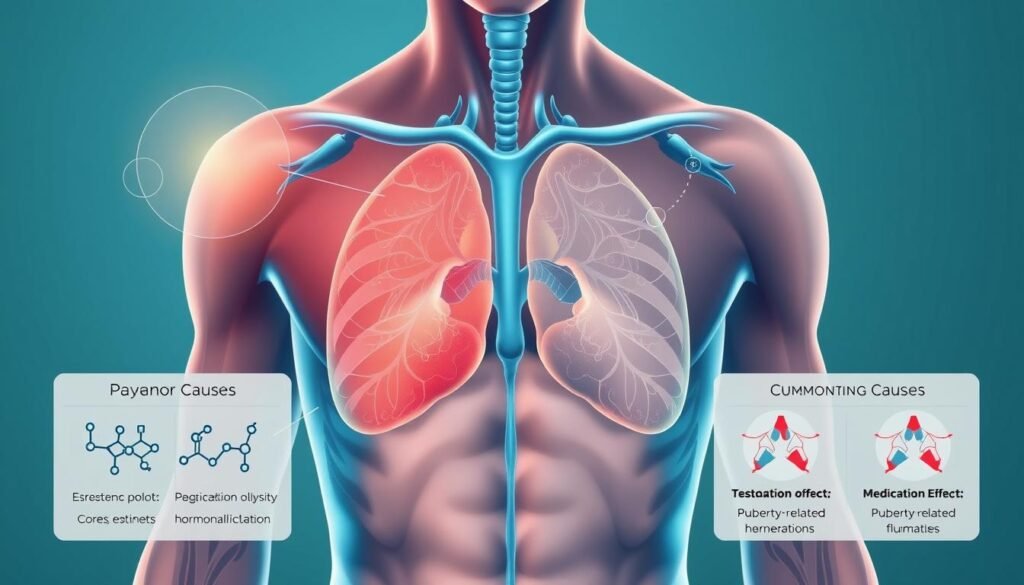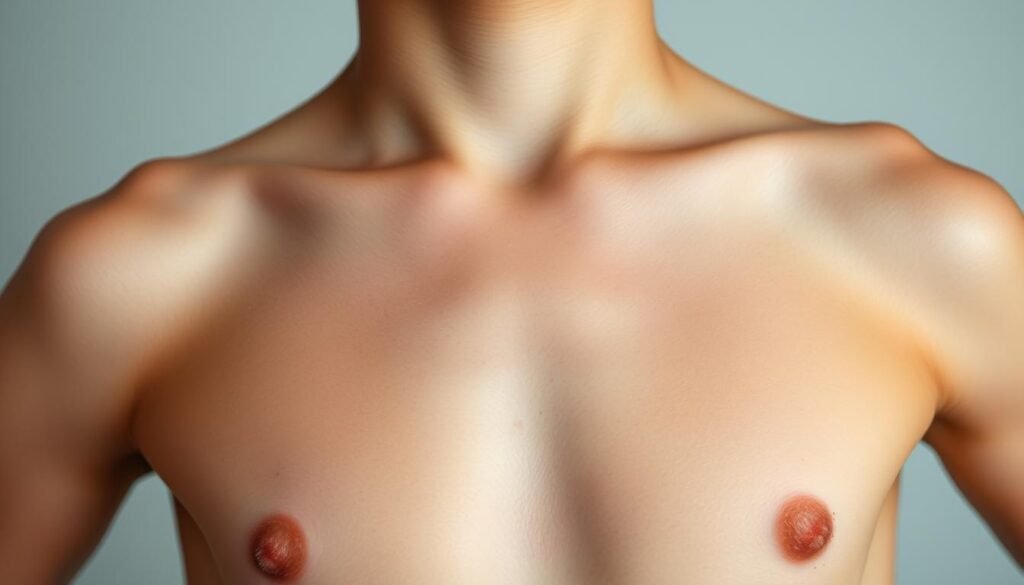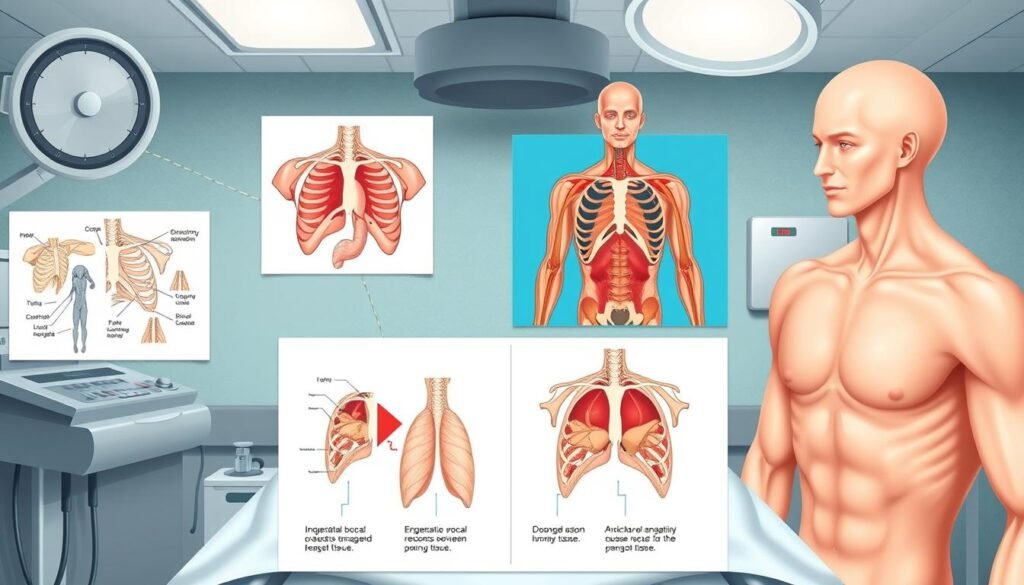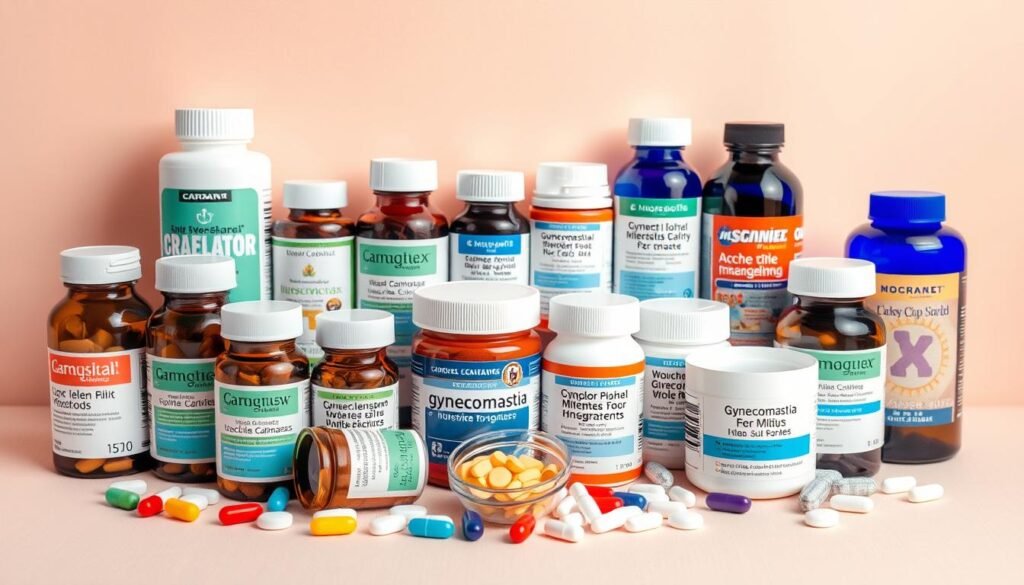As a parent, I remember the day my son, Timmy, came to me with a concerned look. He was just entering his teenage years. His body was going through the natural changes of puberty. One of the changes he noticed was the development of enlarged breast tissue, a condition known as gynecomastia.
Gynecomastia is a common occurrence during the pubescent years. It affects between 50 and 65 percent of males worldwide. It can be a source of anxiety and self-consciousness for young boys. But with the right approach, it can be managed effectively.
Key Takeaways
- Gynecomastia is a common condition that affects many young boys during puberty, often lasting 6 months to 2-3 years.
- Hormonal changes and certain medications or substances can contribute to the development of gynecomastia.
- Natural remedies, lifestyle changes, and medical treatments can help reduce the appearance of gynecomastia.
- Surgical options, such as male breast reduction, may be considered in severe cases or when other treatments are ineffective.
- Addressing the emotional impact of gynecomastia and building self-confidence is an important part of the journey.
As a concerned parent, I’ve done extensive research on this topic. I’m eager to share my insights with other families navigating the challenges of gynecomastia during puberty. In this comprehensive article, we’ll explore the causes, symptoms, and various treatment options. We aim to help your teenage son overcome this common condition and feel confident in his own skin.
What is Gynecomastia?
Gynecomastia is when males have too much breast tissue. It can look like a small, firm lump under the nipple. Or, it can make the breast area bigger. It’s a normal part of male breast development, happening at birth, during puberty, and later in life.
Understanding the Condition
Gynecomastia happens when there’s an imbalance of hormones like testosterone and estrogen. Some men might also have extra fat in their chest, called pseudogynecomastia. But true gynecomastia has glandular tissue that feels like a lump under the skin.
Prevalence of Gynecomastia in Puberty
During puberty, up to 70 percent of males get gynecomastia because of hormone changes. About 90 percent of teens with this condition will outgrow it in one to two years. But, for some, it can stick around into adulthood, affecting up to 20 percent of those who had it as teens.
“Gynecomastia is a common condition that often resolves on its own, but in some cases, it may require medical intervention or even surgery if it persists into adulthood.”
Causes of Gynecomastia During Puberty
Gynecomastia is when male breasts get bigger. It happens because of changes in hormones during puberty. The balance between testosterone and estrogen is key in this process.
Hormonal Changes
Puberty brings big changes in hormones. This can upset the balance between testosterone and estrogen. When estrogen goes up, some boys grow extra breast tissue. This hormonal shift is the main cause of gynecomastia during puberty.
Other Contributing Factors
While hormones are the main reason for gynecomastia due to hormones in puberty, other things can also play a part:
- Some medicines, like anti-androgens and anabolic steroids, can mess with hormone levels and cause gynecomastia from drugs and medications.
- Using drugs like alcohol and marijuana can also lead to gynecomastia.
- Medical issues, like liver or kidney problems, and hormone-related tumors, can also cause causes of gynecomastia during puberty.
It’s often hard to find out why someone gets gynecomastia during puberty. For many boys, it’s just a normal part of growing up.
Symptoms and Signs of Pubertal Gynecomastia
Puberty can be tough, and many teenage boys face gynecomastia, a condition that makes their breasts bigger. This can make them feel really self-conscious. Knowing the signs of gynecomastia in teenage boys and the symptoms of gynecomastia puberty can help them feel more confident.
The main sign of gynecomastia is bigger breasts. Sometimes, one breast grows more than the other. Boys might also feel a small, rubbery lump under their nipple, and the breast might hurt or feel sore, especially at first.
Studies show that up to 70 percent of males in early to mid-puberty get gynecomastia because of hormonal changes. Being overweight can also contribute, as male hormones can turn into female hormones in fat, causing breasts to grow.
“Pubertal gynecomastia usually goes away on its own in early adulthood, but stays in up to 20 percent of people.”
Even though most cases of gynecomastia in teenage boys go away in a few years, it’s key for them to see a doctor if it lasts or bothers them a lot. With the right support, young men can get through this time feeling more confident and comfortable.
Diagnosing Gynecomastia in Teenage Boys
Figuring out gynecomastia, or the growth of breast tissue in boys, often needs a mix of checks and tests. Doctors are key in spotting this common issue in teens.
Physical Examination
The first thing to do is a detailed check-up. The doctor will:
- Look at the chest for any signs of breast growth
- Feel the chest to see if there’s breast tissue
- Check how the breast tissue feels
- See if the growth is in one or both breasts
Additional Tests
Even with a check-up, doctors might want to do more tests. This is to make sure there’s no other health issue:
- They might take blood to check hormone levels
- Do a mammogram or ultrasound to look at the breast tissue
- In rare cases, they might take a small tissue sample for a biopsy
These tests for gynecomastia in teens help doctors find out why it’s happening. They then choose the best treatment.
“Up to seven out of 10 teenage boys are likely to develop gynecomastia at some point during puberty.”
How to Get Rid of Gynecomastia During Puberty
If you’re dealing with gynecomastia, or the development of enlarged male breasts, during your teenage years, there are some natural remedies and lifestyle changes you can try to reduce its appearance. While surgical options are available for more severe cases, these natural approaches may be a good starting point.
Natural Remedies and Lifestyle Changes
One of the most effective ways to tackle gynecomastia naturally is through weight loss. Shedding excess body fat can help minimize the appearance of enlarged breasts. Adopt a healthy diet focused on whole, nutrient-dense foods, and incorporate regular exercise into your routine.
Certain supplements may also provide some relief. Turmeric, fish oil, and vitamin E have all been studied for their potential to reduce gynecomastia symptoms. Applying cold compresses to the breasts can also help alleviate swelling and discomfort.
Avoiding substances that can contribute to gynecomastia, such as alcohol and certain medications, is also recommended. Maintaining a healthy sleep schedule and reducing stress levels may provide additional benefits.
| Natural Treatments for Gynecomastia in Teens | Potential Benefits |
|---|---|
| Weight loss through diet and exercise | Reduces appearance of enlarged breasts |
| Turmeric, fish oil, and vitamin E supplements | May help reduce gynecomastia symptoms |
| Cold compresses | Can alleviate swelling and discomfort |
| Avoiding alcohol and certain medications | Helps prevent exacerbation of the condition |
| Maintaining a healthy sleep schedule and reducing stress | May provide additional benefits |
Remember, while these natural remedies and lifestyle changes can be helpful, severe or persistent cases of gynecomastia may require medical intervention. If you’re concerned about your condition, it’s always best to consult with a healthcare professional.
Medication for Treating Pubertal Gynecomastia
In some cases, doctors may prescribe medication to treat gynecomastia. Gynecomastia medication for adolescents and hormone therapy for gynecomastia in teens can help manage this condition during puberty.
A study by Ma NS and Geffner ME in 2008 found that gynecomastia affects up to 65% of boys during puberty. Hormonal changes play a big role, as shown by Moore DC et al. in 1984 and Biro FM et al. in 1990.
Drugs like tamoxifen or raloxifene can block estrogen’s effects and reduce breast tissue. These are usually recommended for severe or persistent cases, as a study from Georgiadis et al. in 1994 suggests.
Research shows that hormones like estrogen, growth hormone (GH), and IGF-1 are crucial in male breast development. Lee PA in 1975 and others found this. Imbalances caused by diseases or medications can lead to gynecomastia.
While medication can help, it’s important to talk to a doctor before starting treatment. The choice of gynecomastia medication for adolescents or hormone therapy for gynecomastia in teens depends on the individual’s situation and how severe the condition is.
Surgical Options for Male Breast Reduction
For some, especially those with severe or long-lasting gynecomastia, surgery is the best choice. Gynecomastia surgery, or male breast reduction, removes extra fat and gland tissue from the chest. It’s often suggested when other treatments fail or cause emotional distress.
When is Surgery Recommended?
Surgery for pubertal gyno might be needed if meds or time don’t help. Gynecomastia that persists, hurts, or embarrasses might need surgery. Studies show gynecomastia often fades on its own, especially in teens, within two years. But if it doesn’t, gynecomastia surgery for teens could be an option.
The Gynecomastia Surgery Procedure
The male breast reduction procedure often uses liposuction and mastectomy. Liposuction removes fat, while mastectomy takes out gland tissue. The choice depends on how bad it is and the person’s body.
Before surgery, tests like blood work, mammograms, and scans might be done. These help the surgeon figure out the best plan for each patient.
“Gynecomastia can be a source of significant emotional distress for many individuals, and surgery can be a life-changing solution for those who have exhausted other treatment options.”
Dealing with the Emotional Impact
Gynecomastia, or enlarged male breasts, can deeply affect teens, especially during puberty. This time is crucial for building self-image and confidence. Gynecomastia can cause anxiety, depression, and feelings of isolation, making teens question their masculinity.
Building Self-Confidence
To tackle the emotional side of gynecomastia in teens, boosting self-confidence is key. This involves seeking help from mental health experts, joining support groups, and doing activities that make you feel good.
- Counseling and therapy help teens deal with their feelings, find ways to cope, and build a positive self-image.
- Support groups, online or in-person, offer a community, validation, and a chance to share experiences with others facing similar issues.
- Physical activities, like exercise or sports, improve health and boost self-confidence and body image.
By emphasizing personal growth, self-care, and a positive outlook, teens with gynecomastia can improve their self-esteem. They can overcome emotional challenges and thrive during this important time in their lives.
“Gynecomastia can be a significant source of emotional distress for young men, but with the right support and strategies, they can learn to embrace their individuality and build the confidence to navigate this challenge.”
Exercises and Workouts for Gynecomastia
If you’re a teen dealing with gynecomastia, or male breast enlargement, you might wonder if exercises can help. While exercise can’t fully get rid of gynecomastia, some exercises can build muscle. This can improve the shape and look of your chest.
Resistance training, like weightlifting or pushups, is very effective. These exercises build muscle in your chest, shoulders, and back. This makes your chest look more defined and masculine. Chest-specific exercises, like bench presses and dumbbell flyes, are also great.
- Pushups are a great exercise to add to your routine. They work your chest, shoulders, and triceps.
- Bench presses and dumbbell flyes are excellent for the chest. They can help reduce excess breast tissue.
- Chin-ups and lat pulldowns are also helpful. They work your back muscles and make your upper body more defined.
While these exercises are helpful, they can’t get rid of gynecomastia on their own. If you’re worried about your chest, talk to a doctor. They can give you advice and suggest treatments, like medicine or surgery.
“The only effective, permanent treatment for gynecomastia is male breast reduction surgery.”
By doing targeted exercises and living a healthy lifestyle, you can manage gynecomastia. This can boost your confidence. But, if gynecomastia doesn’t go away or bothers you a lot, see a doctor. They can help find the best treatment for you.
Preventing Gynecomastia During Puberty
Teenagers often worry about gynecomastia, or enlarged male breast tissue, during puberty. While it’s hard to stop it completely, there are ways to lower the risk and handle it well.
How to prevent gynecomastia in teens and tips to avoid gynecomastia during puberty include:
- Maintain a healthy weight: Too much weight and body fat can lead to gynecomastia. A balanced diet and regular exercise can help manage weight and reduce the risk.
- Avoid drug and medication use: Some drugs, like anabolic steroids and marijuana, can cause gynecomastia. Teens should be careful about substance use that affects hormones.
- Address underlying medical conditions: Health issues like hormonal imbalances and liver disease can raise the risk of gynecomastia. Getting medical help for these conditions is key.
- Practice stress management: Stress can lead to hormonal changes that may cause gynecomastia. Encouraging teens to reduce stress through exercise, meditation, or counseling is helpful.
By living a healthy lifestyle, avoiding harmful substances, and treating any health issues, teens can lower their risk of gynecomastia.
“Gynecomastia is a condition that can occur during puberty in preteen or teenage children due to hormonal changes.”
Even though gynecomastia is common in puberty, it’s crucial for teens and their families to talk to a doctor if they’re worried. With the right steps, teenagers can face the challenges of pubertal gynecomastia and grow with confidence and self-acceptance.
Understanding Pseudogynecomastia
Male breast conditions can be confusing, especially when it comes to gynecomastia and pseudogynecomastia. Both can make the chest look fuller, but they have different causes and treatments.
Gynecomastia is when glandular breast tissue grows, often due to hormonal changes or medical issues. Pseudogynecomastia, however, is caused by too much fat in the chest, not actual breast tissue.
Gynecomastia is most common in newborns, teenagers, and older men. It affects about 50-60% of teenage boys and drops to 20-25% in older men. Pseudogynecomastia, linked to weight gain and obesity, stays even after trying to lose weight.
| Gynecomastia | Pseudogynecomastia |
|---|---|
| Characterized by excess glandular breast tissue | Characterized by excess fatty tissue in the chest |
| Can be caused by hormonal changes, medication, or medical conditions | Primarily caused by obesity and weight gain |
| May require surgical excision of breast tissue for treatment | Often responds well to lifestyle changes and liposuction |
Telling gynecomastia and pseudogynecomastia apart is key because treatment can differ a lot. A doctor’s thorough check-up can figure out the cause. Then, they can suggest the best treatment, like medicine, lifestyle changes, or surgery.
When to Seek Medical Advice
If you or your child notice signs of gynecomastia, it’s important to see a doctor. This is especially true if the issue lasts more than a few months or causes discomfort or emotional pain. A healthcare provider can diagnose the issue, find the cause, and suggest the best treatment.
Gynecomastia is common in puberty, affecting up to 70% of boys. It usually goes away in a few years. But, if it doesn’t, or if it worries you, it’s key to get gynecomastia checked.
Here are some signs you should talk to a doctor about gynecomastia:
- Persistent swelling or enlargement of one or both breasts
- Tenderness, pain, or sensitivity in the breast area
- Visible breast gland tissue or nipple discharge
- Significant emotional distress or self-consciousness about the appearance of your chest
Your doctor will start with a physical check-up and ask about your health history and symptoms. They might suggest blood tests or imaging to find the cause and rule out other issues.
| Condition | Symptoms | Diagnostic Tests |
|---|---|---|
| Gynecomastia | Swollen, tender breasts, breast tissue growth | Physical exam, blood tests, imaging (mammogram, ultrasound) |
| Pseudogynecomastia | Excess fat in the breast area, no breast tissue growth | Physical exam, body composition assessment |
| Breast Cancer | Lump, nipple discharge, skin changes | Physical exam, mammogram, biopsy |
By getting medical help for when to see a doctor for gynecomastia, you can get the right treatment. This might include lifestyle changes, medicine, or surgery. Don’t hesitate to talk to a healthcare provider if you’re worried about breast changes in you or your child.
“Early diagnosis and treatment of gynecomastia can help prevent long-term physical and emotional complications.”
Conclusion
Gynecomastia, or excess breast tissue in males, is common in puberty. It affects up to 65% of boys during this time. While it often goes away on its own, there are ways to help it along and feel good about yourself.
Knowing what causes gynecomastia helps a lot. It can be due to hormones, medicine side effects, or lifestyle choices. You can try natural ways like diet and exercise, or medical options like medication and surgery. These can help make your chest look more masculine.
Getting through gynecomastia in puberty means getting medical advice and trying different things. It’s important to be patient and keep working towards feeling better about your body. With the right help and support, you can get through this and become a healthier, more confident person.
FAQ
What is gynecomastia?
Gynecomastia is when the breast tissue grows too much in males. It can happen in kids and adults with a penis. It often shows up during puberty because of hormonal changes.
How common is gynecomastia during puberty?
Studies show that 50 to 65 percent of males worldwide face this issue at some point.
What causes gynecomastia during puberty?
Hormonal changes, especially in estrogen and testosterone levels, cause it. These changes during puberty can lead to too much breast tissue.
What are the symptoms of gynecomastia in teenagers?
The main sign is bigger breasts. This can happen in one or both breasts. The breasts might grow unevenly.
Some people might feel a small, rubbery lump under the nipple. The breast area can also feel sore.
How is gynecomastia diagnosed during puberty?
Doctors check by doing a physical exam and looking at medical history. They might also do blood tests or a mammogram to check for other issues.
What natural remedies and lifestyle changes can help reduce gynecomastia in teenagers?
Some natural ways and lifestyle changes can help. Losing weight through healthy eating and exercise is one. Drinking less alcohol and certain meds helps too.
Trying supplements like turmeric, fish oil, and vitamin E might also help.
Can medication be used to treat gynecomastia in adolescents?
Yes, sometimes medicine is used to fix hormonal imbalances. Tamoxifen or raloxifene can block estrogen effects and reduce breast tissue.
When is surgery recommended for gynecomastia during puberty?
Surgery might be needed for severe or lasting cases. It removes excess fat and glandular tissue from the chest.
How can teenagers cope with the emotional impact of gynecomastia?
Gynecomastia can really affect teens emotionally. It’s key to seek support and build self-esteem. Counseling, support groups, and focusing on health can help.
Can exercise help reduce the appearance of gynecomastia in teens?
Exercise can’t fully get rid of gynecomastia but can help. Targeted exercises like resistance training, pushups, and chest-focused ones can improve the chest’s shape.
Source Links
- https://www.hopkinsmedicine.org/health/conditions-and-diseases/gynecomastia – Gynecomastia
- https://www.sieberplasticsurgery.com/articles/how-to-get-rid-of-gynecomastia/ – How to Get Rid of Gynecomastia | Sieber Plastic Surgery
- https://www.rajamohanmd.com/how-to-get-rid-of-gynecomastia/ – No title found
- https://www.uptodate.com/contents/gynecomastia-breast-enlargement-in-males-beyond-the-basics – Patient education: Gynecomastia (breast enlargement in males) (Beyond the Basics)
- https://www.bannerhealth.com/healthcareblog/teach-me/what-is-teenage-gynecomastia – Male Boobs: What Is Teenage Gynecomastia? | Banner Health
- https://www.ncbi.nlm.nih.gov/pmc/articles/PMC3706045/ – Gynecomastia in Adolescent Males
- https://www.mayoclinic.org/diseases-conditions/gynecomastia/symptoms-causes/syc-20351793 – Enlarged breasts in men (gynecomastia) – Symptoms and causes
- https://www.childrens.com/specialties-services/conditions/gynecomastia – Gynecomastia in boys – Children’s Health Plastic Surgery
- https://pedsendo.org/patient-resource/pubertal-gynecomastia/ – Pubertal Gynecomastia – Pediatric Endocrine Society
- https://www.nationwidechildrens.org/conditions/gynecomastia – Gynecomastia | Nationwide Children’s Hospital
- https://www.drvitenas.com/blog/what-teens-need-to-know-about-gynecomastia – What Teens Need to Know About Gynecomastia | Blog
- https://www.aafp.org/pubs/afp/issues/2012/0401/p716.html – Gynecomastia
- https://www.mayoclinic.org/diseases-conditions/gynecomastia/diagnosis-treatment/drc-20351799 – Enlarged breasts in men (gynecomastia) – Diagnosis and treatment – Mayo Clinic
- https://www.drsmita.com/blog/how-to-get-rid-of-gynecomastia-3-options/ – How to Get Rid of Gynecomastia: 3 Options | Dr. Smita Ramanadham
- https://emedicine.medscape.com/article/120858-treatment – Approach Considerations, Pharmacologic Therapy, Breast Surgery
- https://www.ncbi.nlm.nih.gov/pmc/articles/PMC6166145/ – Management of adolescent gynecomastia: an update
- https://www.ncbi.nlm.nih.gov/books/NBK279105/ – Gynecomastia: Etiology, Diagnosis, and Treatment – Endotext
- https://www.hopkinsmedicine.org/health/treatment-tests-and-therapies/breast-reduction-in-men-with-gynecomastia – Breast Reduction in Men With Gynecomastia
- https://lagynecomastia.org/gynecomastia-2/emotionally-support-someone-gynecomastia/ – How to Emotionally Support Someone with Gynecomastia – LA Gynecomastia
- https://xsculpt.com/gynecomastia-can-affect-self-esteem/ – The Psychological Impact Of Gynecomastia | XSculpt™
- https://austingynecomastiacenter.com/blog/can-exercise-get-rid-of-gynecomastia/ – Can Exercise Get Rid Of Gynecomastia? Ask An Expert | AGC
- https://www.genesisokc.com/blog/gynecomastia-can-exercise-help-reduce-male-breast-tissue/ – Gynecomastia: Can Exercise Help Reduce Male Breast Tissue?
- https://lookyounger.net/gynecomastia-vs-pseudogynecomastia – Gynecomastia vs Pseudogynecomastia | Dr. Leo Lapuerta
- https://hessandsandeen.com/blog/what-is-pseudogynecomastia/ – Understanding Pseudogynecomastia, Causes and Treatment | Tucson Plastic Surgeons
- https://www.drstoker.com/blog/gynecomastia-in-older-men-understanding-age-related-factors-and-treatment-solutions/ – Gynecomastia in Older Men: Understanding Age-Related Factors and Treatment Solutions – Dr. David Stoker
- https://academic.oup.com/jcem/article/96/1/15/2833174 – Approach to the Patient with Gynecomastia












